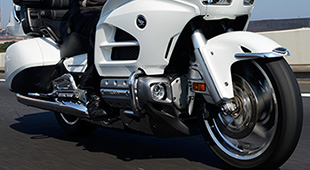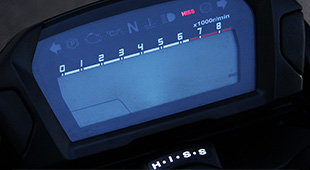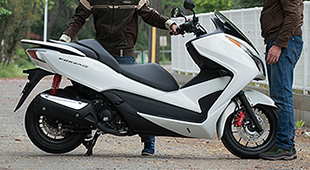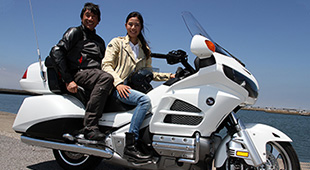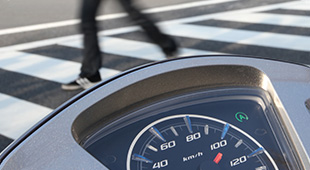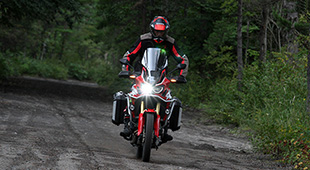Tech Views — Vol. 5 Centerstands
Impressions
The centerstand is an essential part of any motorcycle.
The operating ease of Honda's centerstands is verified by a woman and a boy who have never ridden motorcycles on their own.
I am a motorcycle enthusiast who attaches special importance to whether a bike is equipped with a centerstand or not, or you could say I really love the centerstand. It makes possible solid and stable parking, and is especially convenient when maintenance time comes around. Moreover, when I park my bike on its centerstand during a wash, it lets me easily rotate the rear tire, and even the front with relative ease. And what's more, the centerstand not only gives me a greater sense of confidence when loading luggage, but it is also a great help when fixing a flat tire if ever needed. It's an extremely reliable device for anyone's 'bike life.' Therefore, I really believe that every bike should be equipped with a centerstand.
It may be acceptable for some Superbike or off-road models to not be equipped with centerstands, but I strongly believe that the centerstand is a small but important device that all touring bikes, scooters and road bikes should have. The problem is that, except for lightweight 50cc bikes, larger bikes can often feel too heavy to raise up on their stands until one acquires the knack of raising them. Once the trick of effectively using the centerstand has been mastered, most riders can do it without thinking, and frankly, it really isn't all that difficult to do. It's sort of like a puzzle ring. Once you know how, it's easy.
There are three main steps to using the centerstand:
1) First, when applying the centerstand, the rider stands on the left side of the bike, grabs hold of the handlebar grip with the left hand, and with the right hand grabs the centerstand lift handle, which is usually located somewhere near the left rear underside of the seat.
2) With the right foot, step on and press down the upward-facing centerstand pedal, and balance the bike on both of the stand's feet, confirming that they're both solidly touching the ground.
3) Next, step down firmly on the centerstand pedal while pulling up on the handle with the right hand and leaning your body slightly to the rear.
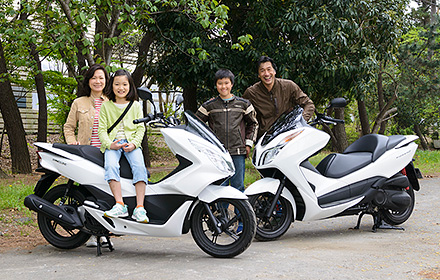
This procedure may seem complicated as written instructions, but once you get the knack, it's almost surprising how easy it is to do on virtually any bike.
Even since entering the field of moto-journalism, I have made it a customary practice to use bikes equipped with centerstands whenever I go out on a reporting job. As such a rider, my personal feeling is that Honda's centerstands are exceptionally easy to use. This isn't simply the feeling that more or less force is needed to prop a bike up on its stand, but is instead the overall impression of its operational feel. Tilting up the bike on its centerstand after finishing a long ride stand also gives a sense of closure, while broadening one's feelings of satisfaction with the day's ride.
There are, of course, other makes and models of motorcycles that don't require very much strength to use their centerstands, but instead unexpectedly require more force to push the bikes off their stands. If we're talking about a large touring model, even I, as an experienced rider, have had some difficulty, which is troubling. The qualities of being light to lift and not requiring a lot of force to move the bike off its stand are equally important.
But more concretely, how much force should be required to raise and lower a bike's centerstand? And how can I prove my basic belief that Honda's centerstands are easy to lift? Of course, I have no laboratory measuring instruments to do the job, only my subjective point of view. And since it all depends on the experience, there really is nothing more than subjectivity to go on, so I had to wonder if this was the right way to approach it.
Frankly, I didn't expect to be bothered so much by a centerstand. Then, suddenly I remembered something. Before I started riding motorcycles myself, a neighborhood high school friend got his first bike. Although we weighed about the same and were in nearly the same physical condition, he was a bit older and shorter in stature than I was, and one day he told me to lift the bike up on its centerstand. I distinctly remember that while he could easily get the bike up, I could not. However, he taught me the trick, and I was soon able to lift it on my own. I distinctly remembered that experience while I was raising and lowering my scooter on its stand. Puzzled at my behavior, my wife looked me straight in the face and asked, "Is something wrong? What are you doing?"
Then, it suddenly occurred to me that my family could be a great resource! While they can't ride motorcycles themselves, my 11-year old son, 9-year old daughter, and wife have all ridden with me on the rear seats of all sorts of motorcycles. Obviously, they don't have driver's licenses and had never used a centerstand before. My kids are pretty average schoolchildren like you'd find anywhere, and their eyes light up with excitement when they hear the terms (Nintendo) DS or (Sony) PSP, though they don't show much interest in the terms CB or VFR. This job of proving how easy a motorcycle's centerstand is to operate was still a bit overwhelming for my young daughter, and so I asked my wife and son to help me with my experiment, saying "Can you give me some assistance, even though it might turn out to be a bit of a strenuous challenge?"
Now the research began into finding out how quickly motorcycle novices can learn to operate a centerstand and, moreover, feel as secure doing it as I do. Our first test began with Honda's small 50cc Zoomer (Ruckus) scooter. I gave both careful instructions before their first attemps, and surprisingly they both successfully got the Zoomer up on its stand their very first try, crying out with delight, "I did it!"
Incidentally, my wife stands 155cm in height and weighs only 48kg, and my son, who was 158cm tall (and growing fast), weighed in at 50kg. They both easily completed the task with such ease that there was hardly anything left to say about it. The Zoomer was indeed so light that you could almost say it rises by magic when the pedal is stepped on. Both test subjects also easily cleared the hurdle of rolling the scooter off its stand, as well.
The next bike on the menu was the larger 125cc-class SH-mode scooter, which, at 116kg (Japan spec), was 26 kg heavier than the Zoomer. Its body also appears to be quite a bit bigger in volume. At first, my son felt a bit intimidated by its larger proportions. As expected, he found it impossible to get the bike up on its stand using only brute strength. So, I initiated him into 'the knack' of raising the stand as described above, and showing him through my own actions, taught him how to use his body to do the job.
With the same nervousness on his face as when holding up a bike on his own, he placed his foot on the stand's pedal, and using the technique learned with the Zoomer, set both of the centerstand's feet on the ground. He then stood on the pedal while pulling up and rearward with his right hand on the scooter's integrated hand grip. As before, he easily and almost unexpectedly succeeded in achieving the desired effect. My wife then easily lifted the scooter up on its stand, just as my son did. In fact, she did it so smoothly and effortlessly that I involuntarily let out a gasp that spoke for the voice in my head saying, "That was easy!" Following that, she also rolled the scooter off its stand with ease. Both tried at least three times while we took photos, but never once did they fail to lift the SH up on its centerstand.
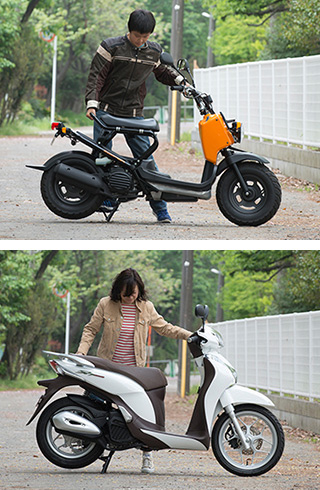
Of course, operation wasn't quite as easy as in the case of the Zoomer. However even for an experienced rider, the SH-mode can be easily lifted by stepping on the centerstand pedal, holding onto the grab bar that doubles as a luggage carrier, and applying only a little force. And yet, the sense of stability when lifted is also maintained. The smooth lifting motion, followed by the stop with a light tapping sound, exuded an excellent overall feeling of quality.
The still larger PCX was next. This is also a 125cc-class scooter, however its 130kg weight (Japan spec) is 14kg heavier than the SH-mode. I arranged for this bike thinking that the time would soon be approaching for reaching the limits of my wife's and son's capabilities, since neither of them rides.
As far as its design is concerned, the PCX looks a lot bigger, but a check of its specifications revealed only a few millimeters difference from the SH-mode in most dimensions, save for its width. Likely confused by his first impression of its long-and-low appearance, my son got a bit nervous and struggled with it unnecessarily. He forgot to first set both of the centerstand's feet on the ground, and then gave it all the strength he had, leaning forward as he pulled, instead of back. With only one leg of its centerstand touching the ground, the PCX's full 130kg weight would feel heavy even to me.
Trying again using the correct procedure, this time he lifted the PCX as smoothly as he did the SH-mode. Once he succeeded in lifting it onto its stand, he repeated the action three more times in response to the cameraman's request of "Once more!" Are you planning to be a bike journalist, son?
My wife also appeared to have quickly learned 'the knack,' and completed the lift in such a smooth and almost effortless motion that it was hard to believe she'd only done it for the first time just 30 minutes before.
This experience told me that while the PCX may be heavier in weight than the SH-mode, its numerical weight was not proportional to the operable weight felt when using the centerstand. One could clearly see how the stand's pivot position and the way it distributes the bike's weight between its feet and the front wheel had been carefully studied during its design. In fact, in the case of the PCX, which has smaller wheels than the SH-mode, I felt that the supporting pivot point was located more to the rear of the body, and that stepping on the stand pedal made it feel as if the full weight of the scooter was being jacked up and lightly floated - giving the impression that the body was lifting almost immediately after I exerted a bit of pulling force with my right hand.

I felt sorry for our two participants, but their success was about to end here.
The last bike in our test was a Forza Si weighing 192kg (Japan spec). This big 250cc scooter was far larger and heavier that the bikes in the 125cc class, and nearly double the weight of the Zoomer they started out on.
However, counter to my expectations, both also easily cleared the Forza Si's centerstand! Although my son took a little longer than with his first attempt on the PCX, he still managed to get it up and securely onto its stand. And though its vehicle weight was fully 16kg more than that of the PCX, the Forza's centerstand raised the scooter up like opening a heavy door as he held the bike up, positioned the centerstand's two feet securely on the ground, and lightly applied lifting force with his right hand while standing on the centerstand pedal.
Next, my wife tried, and raised the Forza up on its centerstand in a quicker, smoother pull than my son. Both said it felt heavy, but neither felt it was too hard to lift.
In fact, when I tried to lift the Forza Si myself, I could clearly feel its full 192kg of weight. However, the very instant I stepped on the centerstand pedal, I could distinctly feel the entire machine rise up. Then, adding in a bit of upward force with my right hand, raised the bike right up onto its stand, just as was done with the SH-mode and the PCX. I then realized that my wife must have been thinking "Lift!" when she put the Forza up on its stand.
I started thinking that the centerstand's mounting position on the frame could be a significant problem, and that by the locating the stand's pivot, or fulcrum, closer to the rear of the machine, the sensation of heavy weight could be greatly reduced. Also the sense of stability felt when the bike is up on its centerstand must have been intentionally designed in.
However, I still had some doubts. They both learned the technique and lifted the bikes up on their centerstands in front of me, but would this also be true for any other makes and models of motorcycles? We decided then that it might be best to test some scooters from other manufacturers as well.

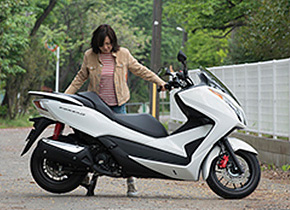

I asked a dealer I know, who sells bikes made by companies X and Y, as well as Hondas, to let us try out some of the scooters he had on display. For our experiment, we selected a couple of Company X's scooter offerings in the 125cc and 150cc class, and from Company Y we selected a 125cc class scooter that's recently been enjoying great popularity in Japan for its compact and comfortable proportions.
First, we tried Company X's 150cc scooter. Initially, my wife was unable to budge it, and even uttered a groan as she strained on the pedal. Since we knew it couldn't be that heavy, she gave it another shot, trying 'the knack' she'd learned earlier. This time she was able to lift the machine up on its stand. Her impression was that "It felt heavy until it began to rise upward, and I didn't like the clunky noise that came out when the centerstand tilted into place." Further, she added that she felt some nervousness when first setting the centerstand's two feet on the ground. This was because the feeling of ground contact seemed less secure than on the Honda scooters she'd tried earlier. Although both can be gotten used to, when I tried it myself, the impression was the same.
As for Company X's 125cc scooter, while lighter in weight than other bikes and scooters in the 150cc class, its feeling of contact between the centerstand's two feet and the ground left quite a bit to be desired, and the clunky metal-on-metal noise of parts striking together when lowering the bike off its stand were the same as noted for the 150cc class scooter. It was, so to speak, somewhat unrefined.
Company Y's 125cc scooter, which has become enormously popular thanks to its compact 50cc-class size, had such a light touch to its centerstand operation that it was unlike anything I'd ever experienced before. At first I thought that this would jeopardize Honda's advantageous position, however I was told that its small body felt surprisingly heavy when pushing it off its stand, and my own experience proved this to be correct. Actually, it gave me a certain feeling of security that the scooter couldn't be easily rolled off its centerstand. However, the big difference in operating force needed to lift and lower made me feel that something wasn't quite right.
Being a curious type, I suddenly thought to compare the lift of a similar Honda scooter, and borrowed a PCX150 that was also on display there. My wife raised it up on its centerstand and exclaimed, "Hey, this feels completely different!" Wondering if this could really be true, I tried it out myself, and it turned out that her first impression was correct. One can viscerally feel that the force doing the lifting is directed straight at both feet of the centerstand, and the stability of the force exerted when lifting, followed by the reassuring thump that indicates the stand has been fully raised were all different. So much so that everybody who actually tried out both back-to-back could easily understand the difference clearly. It was the eureka moment that convinced me of the rightness of my opinion that Honda's centerstands are the best.
I was pleased to clear up what I wanted to know by carrying out this test. Over my years of reporting on new motorcycle models, I'd often heard that Honda pays meticulous attention to even the design of even small regularly-used parts. From lap time indications of speed to braking distances and engine power and torque output, it's meaningless to make things that are difficult to use. And while these may seem to be only a bunch of insignificant details, their importance looms large just the same.
This time, my focus was on centerstands; oft-overlooked items that are frequently used in a rider's daily routine. The results of the day's experiment were a testament to our two test subjects, who had been asked to use a motorcycle centerstand for the first time ever. And as it turns out, once the basics of operation are mastered, anybody can easily handle Honda's centerstands with ease. Just as I thought, the operation of raising and lowering the stand involved little or no trouble, and provided a satisfying sense of quality and security well-suited to the important job done of parking one's treasured motorcycle.
Honda's centerstands are not mere steel bars made to support a motorcycle. They are fundamentally important components of your bike. I hope that each time you finish a test ride, you'll make sure to confirm its centerstand's operation in that last moment. The reason is that you must be able to experience for yourself the same engineering effort put into this lowly stand as Honda puts into its engines, frames, and other designs.
- Top
- Impressions
- User Reviews

